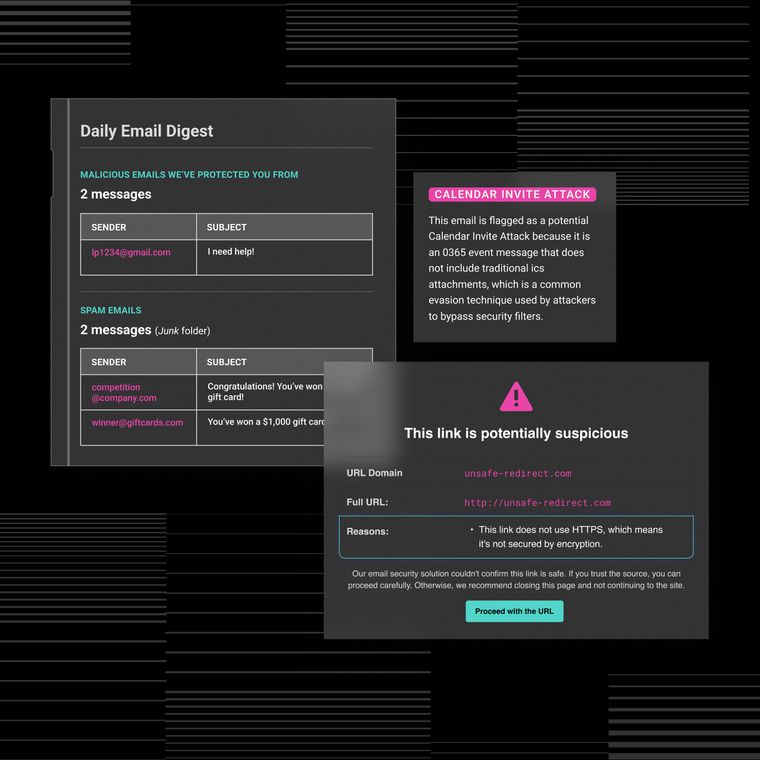Top Essential Skills Every SOC Team Needs for Modern Threat Detection
Discover essential SOC team skills for modern threat detection to boost efficiency and improve security posture.
October 1, 2025
Security Operations Centers (SOCs) that possess specialized skills can prevent advanced threats from having a business impact. Identity-based attacks now drive the majority of breaches, while cloud sprawl and attacker-controlled artificial intelligence erode traditional network perimeters. SOC teams face credential phishing campaigns harvesting single email addresses, machine-to-machine exploits hidden in SaaS APIs, and AI-generated malware iterating faster than signature updates.
That said, let’s understand seven capabilities that reduce dwell time through faster event correlation and decisive remediation.
1. Proficiency in Identity Threat Detection and Response
Identity security requires an "assume breach" mindset, as compromised credentials drive the majority of security incidents. Modern SOC teams integrate comprehensive telemetry to create unified visibility, enabling rapid anomaly detection. This foundation reveals lateral movement indicators when attackers navigate systems to escalate privileges or exfiltrate data.
The key detection capabilities include:
Behavioral Authentication Analysis: Flag abnormal authentication patterns, including logins from unexpected geolocations, to provide early warning of credential misuse. These deviations from established baselines reveal compromised accounts before attackers establish persistence or access sensitive resources. When patterns break from normal user behavior, automated systems trigger immediate investigation protocols.
Continuous Privilege Monitoring: Track privilege escalation attempts continuously, as attackers frequently exploit newly acquired credentials to gain higher access levels. Real-time visibility into permission changes enables immediate response before lateral movement occurs. This monitoring catches subtle permission creep that manual reviews miss entirely.
Real-world scenarios demonstrate this approach effectively. When employees' credentials are compromised through phishing attacks, attackers attempt to execute lateral movement for privileged access. Detection strategies that identify abnormal behavior patterns can thwart breaches before damage occurs. Behavioral graph technology intercepts account takeover attempts before they succeed, significantly reducing the impact of incidents.
2. Behavioral Analysis and Anomaly Detection
Network behavior analysis identifies advanced cyberattacks by revealing threats through behavioral deviations, rather than relying on rule-based alerts. This granular view of digital activity catches subtle breaches that signature-based methods miss. Comprehensive behavioral baselines for users, accounts, and entities enable outlier identification through peer group comparisons.
For instance, the time-of-day anomalies reveal patterns such as impossible travel scenarios where activities log in disparate locations at unlikely times. Correlating rare events provides a comprehensive picture of complex attack vectors. Machine learning continuously enriches this process by refining detection systems and adapting to new threat tactics.
Organizations using these methods preempt significant security incidents by detecting unusual admin activities weeks before ransomware execution. Behavioral AI engines flag deviations signaling impending threats through proactive pattern analysis. This approach significantly reduces attacker dwell time while streamlining response efforts and minimizing potential damage across the enterprise.
3. Cloud and SaaS Visibility Management
Comprehensive visibility across digital assets has become a necessity for modern Security Operations Centers. Workloads spanning multiple cloud providers make expanded SOC visibility critical for maintaining security posture. Managing this complexity requires structured approaches to data collection and analysis.
Managing complex cloud environments includes:
Centralized Log Aggregation: Establish unified log collection across all cloud environments as the foundation for security monitoring. Integrate APIs with SaaS applications to seamlessly detect misconfigurations and unauthorized changes, while maintaining user context across platforms. This aggregation creates a single source of truth for security events across the distributed infrastructure.
Machine-to-Machine Monitoring: Track automated communications between services and applications to detect anomalous API usage patterns. These interactions often reveal supply chain attacks or compromised service accounts before human users notice issues. Monitoring service-to-service communications catches attacks that bypass traditional user-focused security controls.
Continuous monitoring operates as a non-negotiable requirement for cloud security. Cross-channel coverage provides protection across multiple platforms, including email, Slack, and Teams, simultaneously. Additionally, unified visibility accelerates triage processes and coordinates responses effectively, thereby reducing the time between detection and containment.
4. Automation and Orchestration Skills
Automating repetitive tasks enhances analyst productivity while preventing teams from being overwhelmed by constant alert streams. Automation significantly accelerates triage and response processes, allowing analysts to focus on complex investigations that require human judgment.
Security Orchestration, Automation, and Response (SOAR) platform integration enables the seamless development of playbooks. This supports automated alert enrichment, providing valuable context to raw data. Critical actions, such as orchestrated quarantine and containment, execute smoothly alongside structured approval workflows, ensuring responses maintain both speed and control.
Metrics tracking continuously refines processes: measure automation coverage rates, track reductions in false positives, and monitor improvements in response times. Well-orchestrated automated response workflows demonstrate reductions in Mean Time to Recovery. Striking a balance between automated efficiency and human oversight ensures sophisticated judgment complements machine-driven process efficiency.
5. Threat Intelligence Enrichment
Threat intelligence enrichment transforms raw SIEM alerts into prioritized incidents by adding critical context that drives immediate action. This process eliminates guesswork and accelerates response times across security operations. Enrichment aggregates data from curated open-source feeds, paid intelligence services, internal incident history, and dark web monitoring.
Automation pipes indicators through enrichment APIs attaching geolocation data, threat actor associations, and MITRE ATT&CK techniques. Context enables accurate risk scoring and automatic escalation of truly critical events. Routine phishing alerts shift to top priority when enrichment reveals sender domains connecting to active ransomware campaigns targeting financial firms. Without context, alerts remain buried in queues; with proper enrichment, they jump to immediate investigation status.
Remember, enrichment pipelines continuously learn from environments. Also, past incidents form an internal knowledge base, sharpening future detections, while shared community data adds an external perspective. Mapping alerts to attacker tactics accelerates root cause analysis and guides containment steps, such as blocking suspicious IP addresses or forcing password resets.
6. Communication and Collaboration
Clear communication transforms technical security findings into actionable business decisions. SOC teams must translate complex incident data into executive language that drives swift response while maintaining operational alignment across departments. Here are two immediate steps organizations can take:
Incident Response Protocols: Define escalation paths, notification requirements, and stakeholder responsibilities before incidents occur. Clear communication channels prevent confusion during high-pressure situations, ensuring teams coordinate effectively when every second counts.
Post-Incident Documentation: Create detailed retrospectives that capture lessons learned and compliance requirements. This documentation drives continuous improvement while providing metrics that demonstrate the effectiveness of security.
Board-ready dashboards translate technical metrics into business risk language, securing executive support and resources. When SOC teams communicate their security posture through clear visualizations and relevant KPIs, organizations can make informed decisions that strengthen their overall defense capabilities.
7. Continuous Learning in AI and Emerging Threats
Attackers iterate faster than static defenses, making continuous learning the cornerstone of effective threat detection. SOC teams must understand AI-driven techniques as relentlessly as adversaries refine theirs. Modern detection models thrive on constant learning, retraining with live data to identify subtle behavioral shifts that signal compromise.
Platforms that incorporate feedback loops quickly adapt when user routines change or when new tactics, such as living-off-the-land lateral movement, appear in logs. Behavioral analytics platforms continuously refine baselines and reduce false positives, creating detection engines that improve with every data point. Systems detect novel attacks by recognizing deviations from established patterns, rather than relying solely on known signatures.
Effective SOC teams build structured learning programs, which include tracking adversarial AI techniques, testing emerging threats in isolated sandboxes, monitoring models for drift, and retraining when accuracy slips. Sharing lessons across teams ensures every analyst benefits from new insights, strengthening defenses across all attack vectors.
Transform Your SOC With Advanced Behavioral AI
Mastering these seven essential skills creates SOCs that identify and neutralize sophisticated attacks before business impact occurs. Identity threat detection, behavioral analysis, and cloud visibility form the technical foundation. Automation and threat intelligence multiply team effectiveness while communication ensures organizational alignment. Continuous learning keeps defenses evolving alongside emerging threats.
Organizations that adopt AI-driven behavioral insights gain strategic advantages, including faster detection through pattern recognition, reduced false positives via machine learning refinement, and automated response capabilities that compress incident timelines. These technologies address the fundamental limitation of traditional methods that cannot match the speed and sophistication of modern attacks.
Ready to enhance your SOC capabilities with behavioral AI? Get a demo to see how Abnormal can multiply your team's effectiveness against sophisticated attacks.
Related Posts
Get the Latest Email Security Insights
Subscribe to our newsletter to receive updates on the latest attacks and new trends in the email threat landscape.


